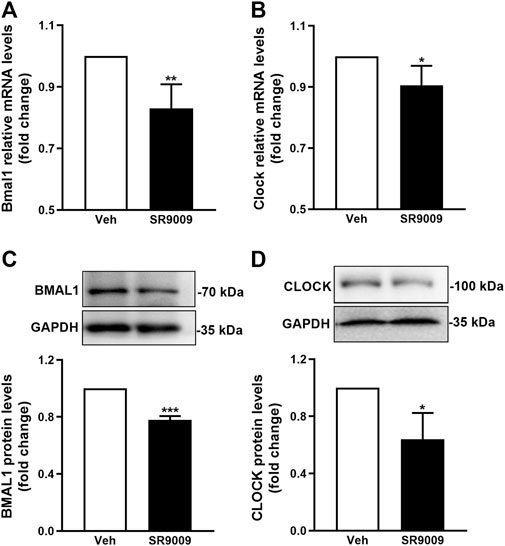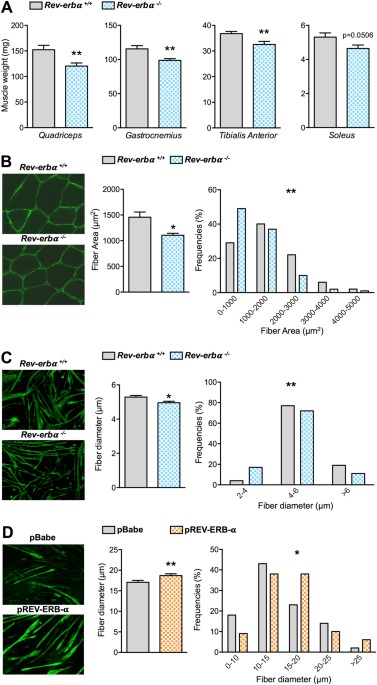The circadian rhythm doesn't just regulate sleep cycles, it plays a critical role in metabolic regulation and by extension determines ones level of disease & inflammation. In order to maintain homeostasis and promote survival, the circadian clock coordinates and maintains the 24-hour rhythmicity of various physiological processes, the most evident are the sleep/wake and fasting/feeding cycles. Disruption of the clock has been associated with an increased susceptibility and/or development of sleep and metabolic disorders. Proper circadian function occurs in response to synchronous expression of the molecular machinery of the circadian clock, composed of a central pacemaker in the suprachiasmatic nucleus (SCN) residing in the hypothalamus. While the master clock is entrained by light, almost all cells in the body harbor peripheral clocks that are entrained by both signals from the master clock and environmental cues.
The REV-ERBα/β complex is one of the key gene suppressors/activators that is responsible for the function of the circadian core clock machinery. Before I explain REV-ERB's function you need to understand how the circadian rhythm functions:
The activation of the genes BMAL1 (brain and muscle arnt-like protein 1) and CLOCK (circadian locomotor output cycles kaput) positively regulate the activation/transcription of Per (period) and Cry (cryptochrome) causing a negative feedback loop that suppresses BMAL1/CLOCK. In doing this the Per/Cry complex is repressing CLOCK from activating Per/Cry in the first place which causes a 24h oscillation in Per/Cry levels. To break down further:
BMAL1 and CLOCK, heterodimerize and drive the expression of Cryptochrome (Cry1, 2) and Period (Per1-3). Once Cryptochrome and Period proteins reach a critical threshold, PER:CRY complexes translocate to the nucleus to repress Bmal1:Clock transactivation.
BMAL1/CLOCK (CLOCK complex) → activation of Per/Cry → suppression of CLOCK → suppression of Per/Cry
Okay, so how does REV-ERBα/β play a role in this cascade?
REV-ERB operates on a different part of the clock machinery. It doesn't directly interact with the CLOCK complex. Instead, REV-ERB represses Bmal1 expression. This means that when REV-ERB is active, less BMAL1 is available, which weakens the ability of CLOCK to drive the expression of Per/Cry. In the daytime, REV-ERB levels are high, so Bmal1 is repressed. In the nighttime, REV-ERB levels fall, allowing Bmal1 expression to rise again, which enables the next cycle of Per and Cry transcription. So to break it down again:
REV-ERBα/β → suppression of BMAL1/CLOCK → weakened expression of Per/Cry → inhibition of the negative feedback loop
When we agonise REV-ERBα/β with a synthetic ligand (SR9009 or SR9011) we are interrupting this process by positively bolstering REV-ERB's ability to suppress the negative feedback loop via it's inhibition of BMAL1/CLOCK expression
BMAL1 and CLOCK, heterodimerize and drive the expression of Cryptochrome (Cry1, 2) and Period (Per1-3). Once Cryptochrome and Period proteins reach a critical threshold, PER:CRY complexes translocate to the nucleus to repress Bmal1:Clock transactivation.
BMAL1/CLOCK (CLOCK complex) → activation of Per/Cry → suppression of CLOCK → suppression of Per/Cry
Okay, so how does REV-ERBα/β play a role in this cascade?
REV-ERB operates on a different part of the clock machinery. It doesn't directly interact with the CLOCK complex. Instead, REV-ERB represses Bmal1 expression. This means that when REV-ERB is active, less BMAL1 is available, which weakens the ability of CLOCK to drive the expression of Per/Cry. In the daytime, REV-ERB levels are high, so Bmal1 is repressed. In the nighttime, REV-ERB levels fall, allowing Bmal1 expression to rise again, which enables the next cycle of Per and Cry transcription. So to break it down again:
REV-ERBα/β → suppression of BMAL1/CLOCK → weakened expression of Per/Cry → inhibition of the negative feedback loop
When we agonise REV-ERBα/β with a synthetic ligand (SR9009 or SR9011) we are interrupting this process by positively bolstering REV-ERB's ability to suppress the negative feedback loop via it's inhibition of BMAL1/CLOCK expression
Okay, so why is any of this important for our heatlh and by extension, our looks?
Because, REV-ERB and the cascade of gene expression/suppression plays a VITAL role in circadian-contingent regulation of inflammation, lipid synthesis, mitogenesis/mitochondrial function, muscle function, cancer progression, bile synthesis (hepatoprotection) and more. For those of you who are hesistant to use steroids because of their effects on dyslipidemia (hyperlipidemia) and hepatotoxicity, this is everything you need to know about REV-ERB and it's ligands:
SR9009 and SR9011 are potent agonists at REV-ERBα (most activity occurs here) and REV-ERBβ (very potent but less so than at alpha). These drugs are responsible for directing metabolic function in a circadian manner. To make this guide more digestible I'll break down SR9009/11's effects into categories, starting with Lipids:
Mice lacking REV-ERBα show impaired lipid metabolism, leading to elevated levels of triglycerides and free fatty acids in the liver. In contrast, activation of REV-ERBα reduces triglycerides and free fatty acids in mice. This lipid-lowering effect is linked to the transcriptional repression of ApoC-III, which plays a crucial role in triglyceride metabolism by inhibiting the breakdown of triglyceride-rich particles, and Elovl3, which is involved in the elongation of fatty acids to generate very long-chain fatty acids[1] The REV-ERB nuclear receptors have been shown to play a key role in regulating lipid metabolism. It has been demonstrated that pharmacological activation of Rev-erb reduced plasma cholesterol levels in mice, while others found that mice lacking Rev-erb had elevated plasma cholesterol levels. Findings reveal that Rev-erb coordinately regulates most of the genes encoding critical enzymes involved in the cholesterol biosynthesis pathway[2]. It seems to inhibit the rate limiting enzyme in cholesterol synthesis (cyp7a1/cholesterol 7α-hydroxylase)[3]
In the aforementioned study it was found that these mice experienced a reduction of 36% and 41% in total cholesterol and LDL cholesterol upon activation of the Rev-erb. A previous study reported an increase in plasma LDL and cholesterol in REV-ERB knockout mice which further supports the notion that REV-ERB negatively regulate cholesterol levels. This is incredibly important for users of steroids because AAS cause a dose-dependent increase in LDL and a decrease in HDL. In another study, the plasma cholesterol analysis of rats that were fed a high-cholesterol diet showed significant reduction in total cholesterol (36%), LDL-C (41%) and triglycerides (40%) in response to SR9009 treatment. HDL-C levels were not affected by SR9009[4]
Not only does REV-ERB activation significantly reduce total cholesterol levels, it regulates macrophages M1 and M2, the ratio of which plays an important role in the development of atherosclerosis. Dyslipidemia and inflammation is responsible for plaque build up in the arteries and REV-ERB knockout mice are proven to have dysregulated ratios between M1 and M2. M1 is pro-inflammatory and cytotoxic, whereas M2 is anti-inflammatory. REV-ERB deficient mice have higher levels of M1 and in conjunction with hyperlipidemia (high total cholesterol) the development of atherosclerosis is majorly increased. SR9009 treatment of bone marrow-derived mouse macrophages (BMDM) reduced the polarization of BMDMs to pro-inflammatory M1 macrophage while increasing the polarization of BMDMs to anti-inflammatory M2 macrophages. Essentially, the introduction of SR9009 normalized the aberrant levels of M1 and increased the levels of M2.[5]
By extension of REV-ERB's effect on macrophages and lipid synthesis, it is highly cardioprotective. However, the inhibition of cardiac fibrosis plays a much larger role in it's cardioprotection. SR9009 prevents cardiomyocyte hypertrophy, reduces fibrosis, and halts heart failure progression in mice. Additionally, SR9009 improves left ventricular function and increases survival rates following myocardial infarction. It also reduced the expression of cytokines IL-6, MMP9, and limited immune cell infiltration (pro-inflammatory macrophages) in the heart. In mice with pressure-induced cardiac hypertrophy caused by transverse aortic constriction, SR9009 lowered protein kinase B (AKT) expression and reduced cardiac hypertrophy[6]
REV-ERBα plays a key role in glucose homeostasis and the development of diabetes by regulating glucose synthesis and the function of pancreatic α and β cells. Activation of REV-ERBα lowers both cellular and plasma glucose levels. Similarly, mice lacking REV-ERBα exhibit elevated plasma glucose levels.[7] Anecdotally, my hba1c levels haven't breached 5mmol/L since starting SR9009.
REV-ERBα activation by SR9009 inhibits transcription of inflammatory factors IL-1β, IL-6, MMP-9, and Ccl2 in astrocytes. SR9009 significantly attenuates hepatic damage and inflammatory responses, it is effective in suppressing clinical markers of liver damage, circulating lipids, hepatic fibrosis, and markers of inflammation. In addition, pharmacological activation of REV-ERBα by SR9009 alleviated hepatic steatosis, insulin resistance, liver inflammation, and fibrosis in CL diet-induced NASH mice. These effects were accompanied by improved gut barrier function and altered microbial composition and function in NASH mice, and the effect tended to be stronger when SR9009 was injected at ZT0 (night time) Moreover, SR9009 treatment at different time points resulted in a marked difference in the composition of the microbiota, with a stronger effect on the enrichment of beneficial bacteria and the diminishment of harmful bacteria when SR9009 was administrated at night.[8, 9, 10]
SR9009 potently regulates mitogenesis (the formation of new mitochondria) and mitochondrial respiration. In one study dealing with REV-ERBα knockout mice, cellular effects resulted in both impaired mitochondrial biogenesis leading to compromised exercise capacity. On a molecular level, REV-ERBα deficiency resulted in deactivation of the Lkb1-Ampk-Sirt1-Ppargc-1α signaling pathway.[11] Additionally, genes encoding enzymes of fatty acid β-oxidation, like carnitine palmitoyltransferase 1b (Cpt1b), long chain acyl-CoA dehydrogenase (Acadl), short chain acyl-CoA dehydrogenase (Acads), Ucp2, and Ucp3, genes involved in skeletal muscle metabolism, were also upregulated with REV-ERBα overexpression.[12] Researchers have demonstrated that mice lacking REV-ERBα had decreased skeletal muscle metabolic activity and running capacity. Burris’ group showed that activation of REV-ERBα with SR9009 led to increased metabolic activity in skeletal muscle in both culture and in mice. The treated mice had a 50 percent increase in running capacity, measured by both time and distance.[13].
“The animals actually get muscles like an athlete who has been training,” said Burris. “The pattern of gene expression after treatment with SR9009 is that of an oxidative-type muscle— again, just like an athlete.”
Speaking of muscles, glucocorticoids seem to negatively regulate REV-ERB expression, REV-ERBα mRNA levels were shown to be down-regulated by dexamethasone in the liver and in both rat and human primary hepatocyte cultures in one study[14]. In another study, REV-ERBα overexpression partially or totally blunted dexamethasone-mediated induction of the catabolic (Atrogin, Murf1, Foxo1 and Foxo3a) and anti-anabolic (Klf15, Redd1 and Bcat2) genes[15]. This means SR9009 is HIGHLY anticatabolic because cortisol/glucocorticoid agonism is one of the most potent regulators of muscle catabolism. The fact that SR9009 was able to completely abate dexamethasone induced catabolism is astounding, imagine what it's capable of doing in the presence of anabolics.
It's exercise in pill form essentialy, and it doesn't cause cancer like Cardarine, quite the contrary actually.

REV-ERBs are potently anticarcinogenic. It's getting too good to be true.
In one study, it was found that cancer cell proliferation was reduced with the use of the REV-ERBα agonist SR9011 as well as with an RORα agonist. Regarding gastric cancer, it was determined that REV-ERBα expression was decreased in tissues of patients with gastric cancer, which was correlated with poor differentiation and lymph node metastasis. In addition, decreased REV-ERBα expression was associated with poor prognosis. Another study focusing on glioblastoma investigated the proliferation dependence on clock genes among different cell states of glioblastoma cells, namely, the glioblastoma stem cells, differentiated glioblastoma cells, and non-malignant brain cells. The GSCs only exhibited a strong dependence on clock-related transcription factors. The treatment with the small-molecule agonists of REV-ERBs SR9011 and SR9009 led to a reduction in the GSC proliferation rate.[16]
Okay so how do we use SR9009?
SR9009 has an estimated half life of around 4-6h, that means it's in and out of the body relatively quickly and that's exactly what we want, REV-ERB regulates orexinergic genes (orexin 1/2 are neuropeptides involved in sleep onset and maintenance) if taken during the day (SR9009) orexin is supressed, if you take it too close to bedtime you'll have an underactive orexingergic system, not only this, but SR9009 negatively regulates GABA transmission so wakefullness is definitely a perceptible effect of this drug. It also blocks melatonin receptor. The immediate effect of this drug is intense but non-anxiety inducing alertness. Once this drug is out of the body, however, orexin, melatonin & gaba are sensitized. Sleep onset is rapid and sleep maintenance is perfect. SR9009 will positively regulate your circadian rhythm more than any drug supplement (melatonin).
The issue however, is the fact that SR9009 has next to no oral bioavailability, we are required to either brew SR9009 into an oil based injectable, or we can dissolve SR9009 into DMSO and it apply it transdermally (wrists, scrotum and thin veiny areas have the best absorption rates). SR9009 will hold in DMSO at 30mg/ml[17]
For an injectable solution (30ml) we get around 30mg/ml
900mg/.9g of SR9009 raw powder
20% benzyl benzoate
2% benzyl alcohol
78% MCT oil
900mg/.9g of SR9009 raw powder
20% benzyl benzoate
2% benzyl alcohol
78% MCT oil
For a DMSO based solution we can achieve 30mg/ml
30ml 99% pharmaceutical grade DMSO
900mg/.9g of SR9009 raw powder
30ml 99% pharmaceutical grade DMSO
900mg/.9g of SR9009 raw powder
Only apply/inject in the morning and never after midday.
10.1016/j.bcp.2017.02.006
10.3390/ijms232112954
10.7150/thno.43834

 doi.org
doi.org

 doi.org
10.1038/nm.3213
doi.org
10.1038/nm.3213

 doi.org
doi.org

 doi.org
doi.org

 doi.org
doi.org

 doi.org
doi.org
10.3390/ijms232112954
10.7150/thno.43834
REV-ERB agonism improves liver pathology in a mouse model of NASH
Non-alcoholic fatty liver disease (NAFLD) affects a significant number of people worldwide and currently there are no pharmacological treatments. NAFLD often presents with obesity, insulin resistance, and in some cases cardiovascular diseases. There is a clear need for treatment options to...

Frontiers | Rev-erbα agonist SR9009 protects against cerebral ischemic injury through mechanisms involving Nrf2 pathway
Backgrounds: The circadian clock protein Rev-erbα is a crucial regulator of circadian rhythms that affects multiple molecular, cellular, and physiology pathw...
Distinct roles for REV-ERBα and REV-ERBβ in oxidative capacity and mitochondrial biogenesis in skeletal muscle
The nuclear receptors REV-ERBα and REV-ERBβ have been demonstrated to be core members of the circadian clock and participate in the regulation of a diverse set of metabolic functions. Due to their overlapping tissue expression patterns and gene expression profiles, REV-ERBβ is thought to be...

Circadian and Glucocorticoid Regulation of Rev-erbα Expression in Liver*
Abstract. Rev-erbα [NR1D1], a member of the nuclear receptor superfamily, is an orphan receptor that constitutively represses gene transcription. Rev-erbα

Rev-erb-α regulates atrophy-related genes to control skeletal muscle mass - Scientific Reports
The nuclear receptor Rev-erb-α modulates hepatic lipid and glucose metabolism, adipogenesis and thermogenesis. We have previously demonstrated that Rev-erb-α is also an important regulator of skeletal muscle mitochondrial biogenesis and function, and autophagy. As such, Rev-erb-α over-expression...

The Role of REV-ERB Receptors in Cancer Pathogenesis
REV-ERB receptors are members of the nuclear receptor superfamily of proteins, which act as both intracellular receptors and transcription factors, therefore modulating the expression of target genes. REV-ERBs act as transcription repressors because of their unique structure. Their predominant...




















